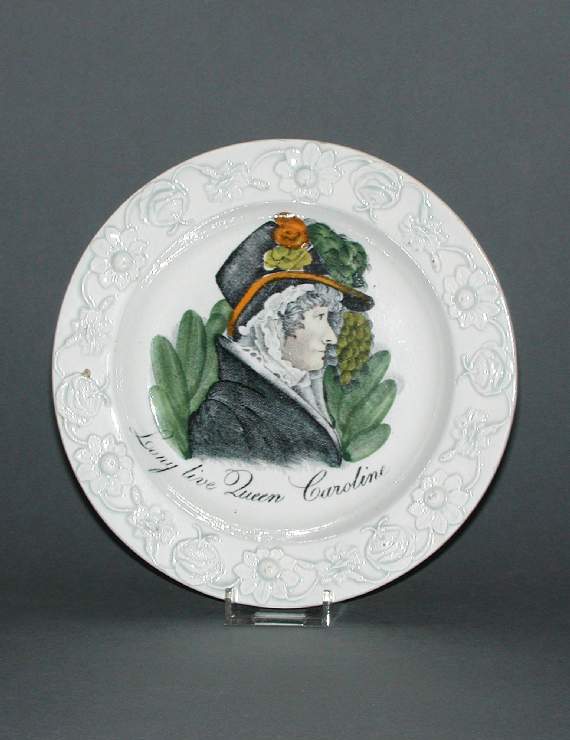Current Location: In storage
Maker(s)
Production:
Unidentified Staffordshire factory
Entities
Categories
Description
Pearlware plate with a floral border in relief, and well transfer-printed and painted underglaze with a bust portrait in profile to right of Queen Caroline, with below, the words, 'Long Live Queen Caroline'
White earthenware, moulded with a border in relief, transfer-printed in black, and painted in green, yellow and orange under lead-glaze which is tinted very pale greyish-blue (pearlware). The circular plate has a narrow sloping rim with a border of relief alternating roses and daisies linked by a wavy stem with a small flower between each of the others. The well has curved sides and a flat centre, and is transfer-printed with a bust portrait in profile to right of Queen Caroline wearing a high-crowned hat decorated with green, yellow and orange feathers, over a white bonnet with frills at the side, and a coat. On either side of her there are large oval leaves. Below in black are the words, 'Long Live Queen Caroline'.
Notes
History note: Dr J.W.L. Glaisher, FRS, Trinity College, Cambridge
Legal notes
J. W. L. Glaisher Bequest
Measurements and weight
Diameter: 15.6 cm
Height: 1.5 cm
Acquisition and important dates
Method of acquisition: Bequeathed
(1928-12-07)
by
Glaisher, J. W. L., Dr
Dating
19th Century, Early
George IV
Circa
1820
CE
-
1821
CE
Note
A similar plate with the portrait printed underglaze in blue is in the Willett collection in Brighton Museum.
Caroline of Brunswick (1768-1821), married her cousin, the future George IV, in 1795, and was Queen from 1820 to her death in 1821. The couple separated after the birth of Princess Charlotte in January 1796. After her daughter's death in 1817, and George IV's accession to the throne, Princess Caroline returned to England. She refused to be divorced from her husband, and became extremely popular with the masses. George IV failed to obtain a divorce through Parliament and barred her from his coronation in July 1821, which made her more popular still. She died a few weeks later, on 7 August, and was taken back to Brunswick for burial.
People, subjects and objects depicted
Components of the work
Decoration
composed of
high-temperature colours
( green, yellow and orange)
ceramic printing colour
Materials used in production
Lead-glaze
Earthenware
Techniques used in production
Moulding
: White earthenware, moulded with a relief border on the rim, transfer-printed in black and painted in green, yellow and orange under lead-glaze
Lead-glazing
Inscription or legends present
- Text: J.W.L. GLAISHER COLLECTION printed and 96/28 hand-written
- Location: On base
- Method of creation: Printed in black and hand-written in black ink
- Type: Label
References and bibliographic entries
Related exhibitions
Identification numbers
Accession number: C.27-1928
Primary reference Number: 73957
Old object number: C.96-1928
Stable URI
Audit data
Created: Saturday 6 August 2011
Updated: Tuesday 30 April 2024
Last processed: Tuesday 13 May 2025
Associated departments & institutions
Owner or interested party:
The Fitzwilliam Museum
Associated department:
Applied Arts




